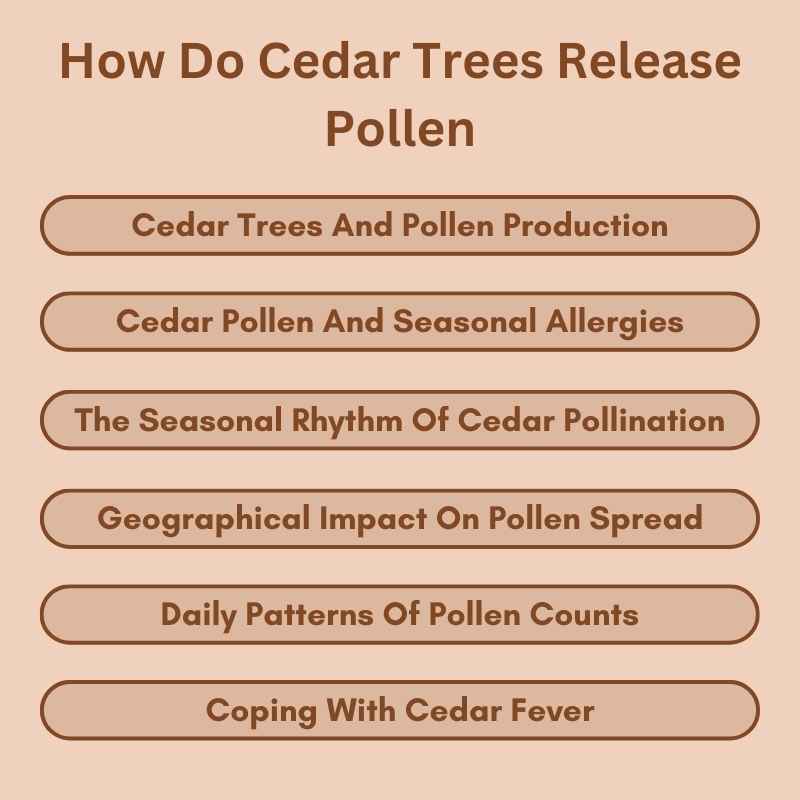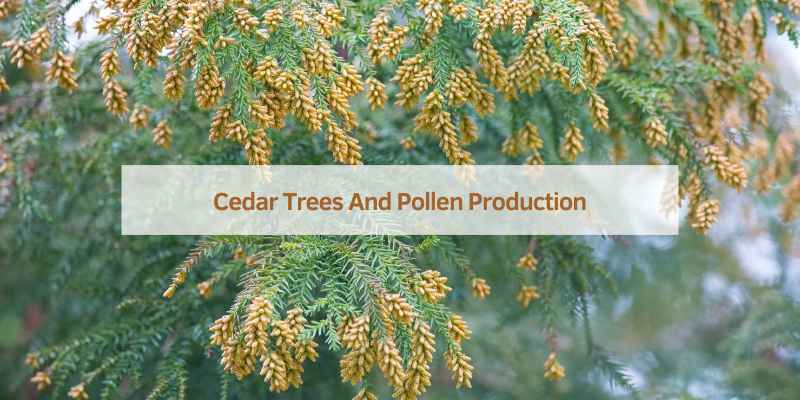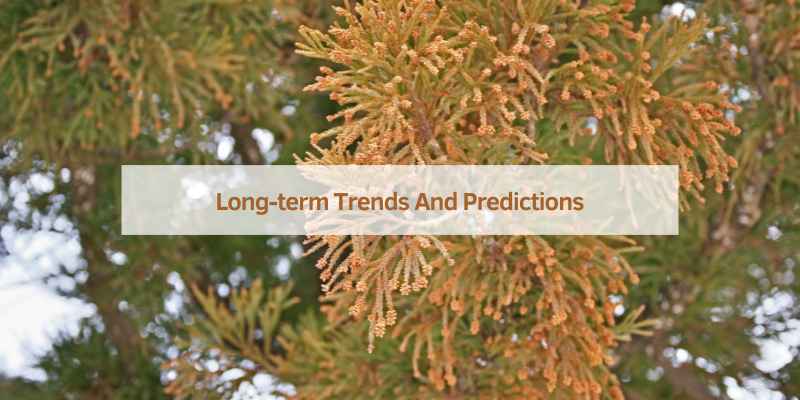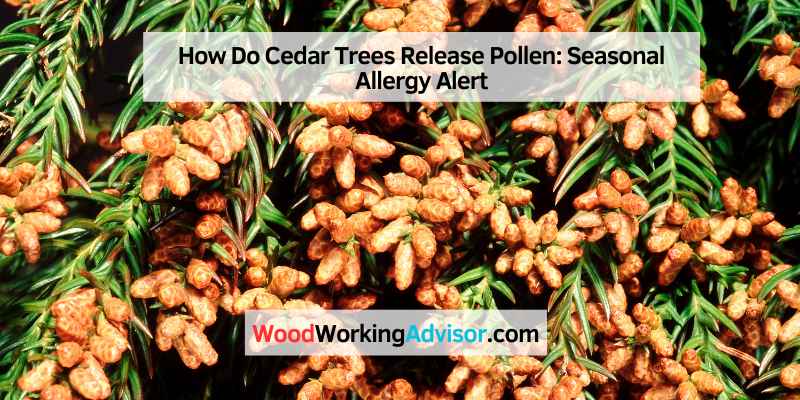Cedar trees release pollen by producing a large quantity of it in the air immediately following a cold front. This unique pollination pattern, specific to cedar and Ashe juniper trees, occurs in the winter rather than the typical spring pollination season.
The pollen is released into the air, where it can travel for hundreds of miles on the wind, causing allergies known as cedar fever. The release of pollen by cedar trees is triggered by colder weather, making it a favorite time for these trees to release their pollen in places like Texas.
This phenomenon results in a significant amount of pollen particles being dispersed into the air, leading to the symptoms associated with cedar fever.

Cedar Trees And Pollen Production
Cedar trees release a large quantity of pollen in the air, and they have a unique pollination pattern. Unlike most other trees that pollinate in the spring, cedar and Ashe juniper trees pollinate in the winter. They release their pollen in the air immediately following a cold front, which is their favorite time to release pollen in Texas.
The Biological Process Of Pollen Release
Cedar trees are known for their unique pollination pattern as they release a large quantity of pollen in the air during winter, immediately after a cold front. The biological process of pollen release starts with the male reproductive structures of the tree, called strobili or cones, which produce pollen grains. These pollen grains contain sperm cells that fertilize the female cones, leading to the production of seeds and the continuation of the species.
Factors Influencing Pollen Dispersal
Several factors can influence the dispersal of cedar tree pollen. Firstly, wind is the primary means of dispersal for cedar pollen, and factors such as wind speed and direction can affect how far the pollen can travel. Secondly, temperature and humidity can also affect pollen dispersal, as high humidity can cause the pollen to clump together, making it less likely to travel long distances. Finally, the density of cedar trees in an area can also influence pollen dispersal, as a higher density of trees can lead to a higher concentration of pollen in the air.
In conclusion, the unique pollination pattern of cedar trees, the biological process of pollen release, and the factors influencing pollen dispersal are all fascinating aspects of the natural world. While cedar pollen can cause allergies and discomfort for some people, it is also an important part of the ecosystem and plays a crucial role in the continuation of the species.

Cedar Pollen And Seasonal Allergies
Cedar trees release pollen in winter after cold fronts, unlike other trees. The pollen cloud triggers cedar fever allergies.
The Impact Of Cedar Pollen On Health
Cedar pollen can have a significant impact on our health, particularly for those who suffer from seasonal allergies. The release of cedar pollen into the air can cause a variety of symptoms, ranging from mild to severe, making it essential to understand the potential effects it can have on our well-being.
Identifying Symptoms Of Cedar Allergies
Recognizing the symptoms of cedar allergies is crucial in managing and treating the condition effectively. Here are some common signs to look out for:
- Sneezing: Frequent and uncontrollable sneezing is one of the most common symptoms of cedar allergies. It can occur repeatedly throughout the day, causing discomfort and irritation.
- Runny or stuffy nose: Cedar allergies can lead to nasal congestion, resulting in a runny or stuffy nose. This can make breathing difficult and impact daily activities.
- Itchy, watery eyes: Allergic reactions to cedar pollen often manifest as itchy and watery eyes. This symptom can be particularly bothersome and affect vision clarity.
- Coughing and throat irritation: Cedar allergies may also cause coughing and throat irritation. This can be accompanied by a scratchy or sore throat, making it uncomfortable to swallow or speak.
- Fatigue and headache: Some individuals may experience fatigue and headaches as a result of cedar allergies. These symptoms can significantly impact daily energy levels and overall well-being.
If you are experiencing any of these symptoms, especially during cedar pollen season, it is important to consult with a healthcare professional for an accurate diagnosis and appropriate treatment plan. Allergy testing may be recommended to determine the specific allergens triggering your symptoms.
Managing cedar allergies typically involves a combination of avoidance strategies and medication. Avoiding exposure to cedar pollen by staying indoors during peak pollen times, using air purifiers, and keeping windows closed can help reduce symptoms. Over-the-counter antihistamines and nasal sprays can provide temporary relief, while prescription medications may be necessary for more severe cases.
By being aware of the impact of cedar pollen on our health and identifying the symptoms of cedar allergies, we can take proactive steps to manage and minimize the discomfort caused by these seasonal allergies. Remember, it is always best to consult with a healthcare professional for personalized advice and guidance.
The Seasonal Rhythm Of Cedar Pollination
Cedar trees have a unique and intriguing pattern of pollination that sets them apart from other trees. Their pollen release does not follow the typical springtime schedule; instead, cedar and Ashe juniper trees engage in winter pollination, making them stand out in the botanical world.
Cedar Trees’ Unique Winter Pollination
Unlike most other trees that pollinate in spring, cedar trees have a distinctive winter pollination pattern. They release a substantial amount of pollen into the air, creating a striking phenomenon, especially right after a cold front. This distinctive behavior makes cedar trees a fascinating subject of study and observation.
Climatic Triggers For Pollen Release
The release of pollen from cedar trees is triggered by colder weather conditions. In regions like Texas, the favored time for cedar trees to release their pollen is immediately following a cold front. This climatic trigger ensures that the pollen release is synchronized with specific environmental cues, adding to the unique charm of cedar tree pollination.
Geographical Impact On Pollen Spread
Cedar trees release pollen in a unique manner, and the geographical location plays a crucial role in the spread of this pollen. Let’s explore the regional variations in cedar pollen distribution and understand how topography affects the dispersion of pollen.
Regional Variations In Cedar Pollen
Regional variations significantly impact the concentration and spread of cedar pollen. Areas with a high population of cedar trees, such as Texas and parts of the southeastern United States, experience a more pronounced impact during the cedar pollen season. This phenomenon influences the severity of cedar allergies in these regions.
How Topography Affects Pollen Distribution
The topography of an area plays a pivotal role in determining the distribution of cedar pollen. For instance, in regions with valleys or enclosed spaces, the pollen concentration may be higher due to reduced air circulation. Additionally, areas with significant wind patterns may witness the spread of cedar pollen over larger distances, affecting a wider population.
Daily Patterns Of Pollen Counts
Cedar trees release pollen in the winter, unlike most other trees that pollinate in the spring. The pollen is released immediately following a cold front, making it a unique pattern compared to other tree species. This can lead to increased pollen counts, especially in the morning and early afternoon.
Understanding Peak Pollen Times
Strategies To Minimize Exposure
Cedar trees release pollen in winter after cold fronts trigger them. Pollen counts peak in midday, affecting allergies. To minimize exposure, stay indoors during peak pollen times and keep windows closed. Use air purifiers and wear masks when outdoors. Be proactive in managing pollen exposure.
Coping With Cedar Fever
Cedar trees release a large quantity of pollen in the air and have unique pollination patterns. Unlike most other trees, cedar and Ashe juniper trees pollinate in the winter, triggered by colder weather, often following a cold front. This can lead to a surge in cedar pollen levels, causing discomfort for those with allergies.
Effective Treatments And Remedies
If you are suffering from cedar fever, there are several treatments and remedies available to alleviate your symptoms. Over-the-counter antihistamines such as loratadine (Claritin) or cetirizine (Zyrtec) can provide relief from sneezing, itching, and runny nose. Nasal corticosteroids like fluticasone (Flonase) or mometasone (Nasonex) can reduce inflammation in the nasal passages and relieve congestion. If your symptoms are severe, your doctor may prescribe a stronger medication such as montelukast (Singulair).
Preventive Measures During High Pollen Season
To avoid cedar fever, it is important to take preventive measures during high pollen season. Stay indoors during peak pollen hours, which are usually in the morning and early afternoon. Keep your windows and doors closed to prevent pollen from entering your home. Use an air purifier with a HEPA filter to remove pollen from the air inside your home. Wear a mask when outdoors to reduce your exposure to pollen. Wash your hands and face frequently to remove any pollen that may have landed on your skin.
Cedar trees release a large quantity of pollen in the air, and this can cause cedar fever, which is a seasonal allergy that affects many people in Texas. The symptoms of cedar fever include sneezing, itching, runny nose, congestion, and headache. To cope with cedar fever, it is important to take preventive measures during high pollen season and use effective treatments and remedies to alleviate your symptoms. By following these tips, you can reduce your exposure to pollen and enjoy the winter season without the discomfort of cedar fever.
Pollen’s Ecological Role
Cedar trees release pollen in large quantities in the air immediately after a cold front, which is their favorite time to do so. Unlike other trees that pollinate in the spring, cedar trees and Ashe juniper trees have unique pollination patterns and release their pollen during the winter.
Reproductive Strategies Of Cedar Trees
Cedar trees have evolved unique reproductive strategies to ensure successful pollination and seed production. Instead of the typical spring pollination period, cedar and Ashe juniper trees release their pollen in the winter, immediately following a cold front. This timing allows them to take advantage of specific weather conditions to maximize the dispersal and fertilization of their pollen.
Pollen’s Function Beyond Causing Allergies
While cedar pollen is often associated with allergic reactions, it serves crucial ecological functions beyond triggering allergies. The release of pollen is essential for the reproductive success of cedar trees, as it facilitates the transfer of male gametes to female cones, leading to the production of seeds. This process is vital for maintaining the genetic diversity and population growth of cedar tree species.
Long-term Trends And Predictions
Researchers have been diligently studying the annual variations in cedar pollen release to understand the patterns and factors that influence the process. By analyzing historical data and conducting extensive field studies, scientists have gained valuable insights into the cyclical nature of cedar pollen release. These studies have revealed intriguing patterns and fluctuations, shedding light on the complex interplay of environmental factors that govern the timing and intensity of pollen dispersal.
Predicting Future Trends In Cedar Pollination
Armed with a deep understanding of the factors influencing cedar pollen release, researchers are now leveraging advanced modeling techniques to predict future trends in cedar pollination. By integrating data on climate patterns, temperature fluctuations, and other relevant variables, scientists aim to forecast the long-term trajectory of cedar pollen release. These predictive models hold immense potential for offering valuable insights into the impact of climate change and environmental shifts on cedar pollination dynamics, enabling us to anticipate and prepare for potential changes in pollen release patterns.

Frequently Asked Questions
What Triggers Cedar Pollen?
Cedar trees release pollen triggered by colder weather, particularly right after a cold front. This is different from other trees that typically pollinate in the spring. Cedar pollen counts are usually highest in the morning and peak by midday or early afternoon.
Cedar fever is an allergy to pollen from mountain cedar or Ashe juniper trees.
How Do Cedars Pollinate?
Cedar trees release pollen by dispersing it in the air during winter, unlike other trees that pollinate in spring.
What Causes Trees To Release Pollen?
Trees release pollen when male flower parts called anthers produce it for reproduction. Pollen is then transferred to female seed cones for pollination.
What Time Of Day Is Cedar Pollen Highest?
Cedar pollen is highest in the morning and reaches its peak by midday or early afternoon. This is when allergies are often the worst due to the high concentration of pollen in the air. Cedar trees release their pollen immediately following a cold front, making that the favorite time for pollen release.
Conclusion
Cedar trees release pollen uniquely during winter, triggered by colder weather conditions. This natural phenomenon creates massive pollen clouds, causing cedar fever allergies. Understanding how cedar trees release pollen helps in managing allergies during peak pollen times. Stay informed and prepared for cedar pollen season.

